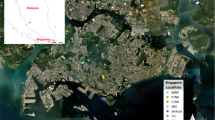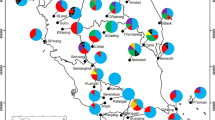Abstract
Equisetum variegatum Schleicher is a circumboreale species of horsetail. In France, it typically grows at high elevations but is very rare in lowlands. The genetic variation of these populations is described using isozyme electrophoresis and PCR-RFLP of chloroplast DNA. Sampled sites were chosen to represent central vs. marginal and/or endangered parts of the distribution area. Extensive clonal multiplication of plants together with the absence of local recruitment by sexual reproduction seem to be responsible for the low genetic diversity observed within populations. Since adaptive response to environmental changes ultimately relies on the presence of genetic variability, clonal populations of E. variegatum may be particularly vulnerable to disturbance. Moreover, in lowland populations, isolation gives no chance to recover new genotypes through migration events. The preservation of the two endangered populations is proposed by propagation by cuttings of all extant genetic individuals. In the case of a disappearance of one genotype in the field, a replacement will be possible. This plan may be sufficient to preserve E. variegatum in the French lowland for several years.
Similar content being viewed by others
References
Alpert P, Lumaret R and Di Giusto F (1993) Population structure inferred from allozyme analysis in the clonal herb Fragaria chiloensis (Rosaceae). American Journal of Botany 80(9): 1002-1006
Barrett SCH and Kohn JR (1991) Genetic and evolutionary consequences of small population size in plants. Implications for Conservation. In: Falkans Holsinger (ed) Genetics and Conservation of Rare Plants, pp 3-30. Oxford University Press, Oxford
Cho YG, Panaud O and McCough S (1996) Cloning and mapping of variety specific rice genomic DNA sequences: amplified fragment length polymorphism (AFLP) from silver-stained polyacrylamide gels. Genome 39: 373-378
Demesure B, Comps B and Petit RJ (1996) Chloroplast DNA phylogeography of the common beech (Fagus sylvatica L.) in Europe. Evolution 50: 2515-2520
Demesure B, Sodzi N and Petit RJ (1995) A set of universal primers for amplification of non-coding regions of mitochondrial and chloroplast DNA in plants. Molecular Ecology 4: 129-131
Duckett JG (1979) An experimental study of the reproductive biology and hybridisation in the European and North American species of Equisetum. Botanical Journal of the Linnean Society 79: 205-229
Duckett JG and Duckett AR (1980) Reproductive biology and population dynamics of wild gametophytes of Equisetum. Botanical Journal of the Linnean Society 80: 1-40
Dumolin-Lapegue S, Pemonge M-H and Petit RJ (1997) An enlarged set of consensus primers for the study of organelle DNA in plants. Molecular Ecology 6: 393-397
Dupuis C and Rapilly D (1953) Activités des naturalistes parisiens. Comptes-rendus des principales excursions de l'année 1953. Cahier des Naturalistes, Bull. N. P 8: 60
Dupuis C and Rapilly D (1956) Comptes-rendus des principales excursions des naturalistes parisiens en 1956. Cahier des Naturalistes, Bull. N. P 12: 117-118
Dupuis C and Rapilly D (1965) Comptes-rendus des principales excursions des naturalistes parisiens en 1958 et 1959. Cahier des Naturalistes, Bull. N. P 21: 74-75
Dupuis C and Rapilly D (1973) Souvenirs d'amitié et de vie naturaliste. Cahier des Naturalistes, Bull. N. P 29: 97
Edwards K, Johnstone C and Thompson C (1991) A simple and rapid method for the preparation of plant genomic DNA for PCR analysis. Nucleic Acids Research 19: 1349
El Mousadik A and Petit RJ (1996) Chloroplast DNA phylogeography of the argan tree of Morocco. Molecular Ecology 5: 547-555
Ellstrand NC and Elam DR (1993) Population genetic consequences of small population size: implications for plant conservation. Annual Review of Ecology and Systematics. 24: 217-242
Ellstrand NC and Roose ML (1987) Patterns of genotypic diversity of clonal plant species. American Journal of Botany 74(1): 123-131
Guffroy C (1935) Note sur la flore de la forê t de Marly et de ses environs. Conférence des sociétés savantes, littéraires et artistiques du Département de Seine-et-Oise, Douziè me Session. Compte Rendu des travaux, pp 67-71
Guillon JM and Raquin C (2000) Maternal inheritance of chloroplasts in the horsetail Equisetum variegatum (Schleich.). Current Genetics 37(1): 53-56
Hamrick JL and Godt MJW (1990) Allozyme diversity in plant species. In: Brown AHD et al. (ed) Plant Population Genetics, Breeding, and Genetic Resources. International Symposium on Plant Population Genetics and Germplasm Resources in Plants, pp 43-63
Hamrick JL, Linhardt YB and Mitton JB (1979) Relationships between life history characteristics and electrophoretically detectable genetic variation in plants. Annual Review of Ecology and Systematics 10: 173-200
Hartl DL and Clark AG (1989) Principles of Population Genetics, Second Edition Sinauer associates, Inc
Haufler CH (1987) Electrophoresis is modifying our concepts of evolution in homosporous pteridophytes. American Journal of Botany 74(6): 953-966
Haufler CH and Soltis DE (1986) Genetic evidence suggests that homosporous ferns with high chromosome numbers are diploid. Proceedings of the National Academy of Sciences of the United States of America 83: 4389-4393
Hollingsworth ML, Bailey JP, Hollingsworth PM and Ferris C (1999) Chloroplast DNA variation and hybridization between invasive populations of Japanese knotweed and giant knotweed (Fallopia, Polygonaceae). Botanical Journal of the Linnean Society 129: 139-154
Jeanpert M (1896) L'Equisetum variegatum Schl. trouvé aux environs de Paris. Bulletin de la Société Botanique de France 43: 272-273
Johannsson ME (1993) Factors controlling the population dynamics of the clonal helophyte Ranunculus lingua. Journal of Vegetation Science 4: 621-632
Jovet P (1936) Excursion du 28 juin 1936 conduite par C. Guinet et P. Jovet et notes d'herborisations en forê t de Marly. Bulletin de la Société des Sciences de la Seine-et-Oise. IV: 70
Korpelainen H and Kolkkala M (1996) Genetic diversity and population structure in the outcrossing populations of Equisetum arvense and E. hyemale (Equisetaceae). American Journal of Botany 83(1): 58-62
Lokki J (1976) Genetic polymorphism and parthenogenetic animal VII. The amount of heterozygosity in diploid populations. Hereditas. 83: 57-64
Löve A, Löve D and Pichi Sermolli REG (1977) Cytotaxonomical Atlas of the Pteridophyta, Strauss and Cramer, Hirschberg
Loveless MD and Hamrick JL (1984) Ecological determinants of genetic structure in plant populations. Annual Review of Ecology and Systematics 15: 65-95
Milton JNB and Duckett JG (1985) Potential allelopathy in Equisetum. Proceedings of the Royal Society, Edinburg 86: 468-469
Nei M (1973) Analysis of gene diversity in subdivided populations. Proceedings of National Academy of Sciences of the United States of America 70: 3321-3323
Nei M, Maruyama T and Chakraborty R (1975) The bottleneck effect and genetic variability in populations. Evolution 29: 1-10
Oostermeijer JGB, Van Eijck MW, Van Leeuwen NC and Den Nijs JCM (1995) Analysis of the relationship between allozyme heterozygosity and fitness in the rare Gentiana pneumonanthe L. Journal of Evolutionary Biology 8(6): 739-759
Pasteur N, Pasteur G, Bonhomme F, Catalan J and Britton-Davidian J (1987) Manuel technique de génétique par électrophorè se des protéines. Lavoisier, Paris
Petit RJ, El Mousadick A and Pons O (1998) Identifying populations for conservation on the basis of genetic markers. Conservation Biology 12(4): 844-855
Prelli R and Boudrie M (1992) Atlas écologique des fougè res et plantes alliées. Lechevalier
Rapilly D and Dupuis C (1955) Activités des naturalistes parisiens. Comptes-rendus des principales excursions de l'année 1955. Cahier des Naturalistes, Bull. N. P 11: 101-102
Rapilly D and Dupuis C (1958) Comptes-rendus des principales excursions de l'année 1957. Cahier des Naturalistes, Bull. N. P 14: 34-35
Rumsey FJ, Russell SJ, Ji X, Barrett JA and Gibby M (1996) Genetic variation in the endangered filmy fern Trichomanes speciosum Willd. In: Camus JM, Gibby M and Johns RJ (eds) Pteridology in Perspective, pp 161-165
Sipes SD and Wolf PG (1997) Clonal structure and patterns of allozyme diversity in the rare endemic Cycladenia humilis var. Jonesii (Apocynaceae). American Journal of Botany 84(3): 401-409
Sokal R and Rohlf FJ (1995) Biometry, 3rd edn. W.H. Freeman and Co., New York
Soltis D (1986) Evidence for diploidy in Equisetum, American Journal of Botany 73: 908-913
Soltis DE and Soltis PS (1989) Isozymes in Plant Biology. Dioscorides Press, Portland, Oregon
Soltis DE, Haufler CH, Darrow DC and Gastony GJ (1983) Starch gel electrophoresis of ferns: a compilation of grinding buffers, gel and electrode buffers, and schedules. American Fern Journal 73: 9-27
Soltis DE, Soltis PS and Noyes RD (1988) An electrophoretic investigation of intragametophytic selfing in Equisetum arvense. American Journal of Botany 75: 231-237
Vrijenhoek RC (1994) Genetic diversity and fitness in small populations. In: Loeschcke V, Tomiuk J and Jain SK (eds) Conservation Genetics, pp 37-53. Experientia Supplementum (Basel)
Weir BS (1990) Genetic Data Analysis. Sinauer Associates, Sunderland, Massachusetts
Author information
Authors and Affiliations
Rights and permissions
About this article
Cite this article
Machon, N., Guillon, JM., Dobigny, G. et al. Genetic variation in the horsetail Equisetum variegatum Schleich., an endangered species in the Parisian region. Biodiversity and Conservation 10, 1543–1554 (2001). https://doi.org/10.1023/A:1011816610775
Issue Date:
DOI: https://doi.org/10.1023/A:1011816610775




